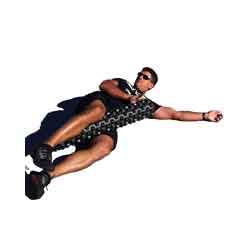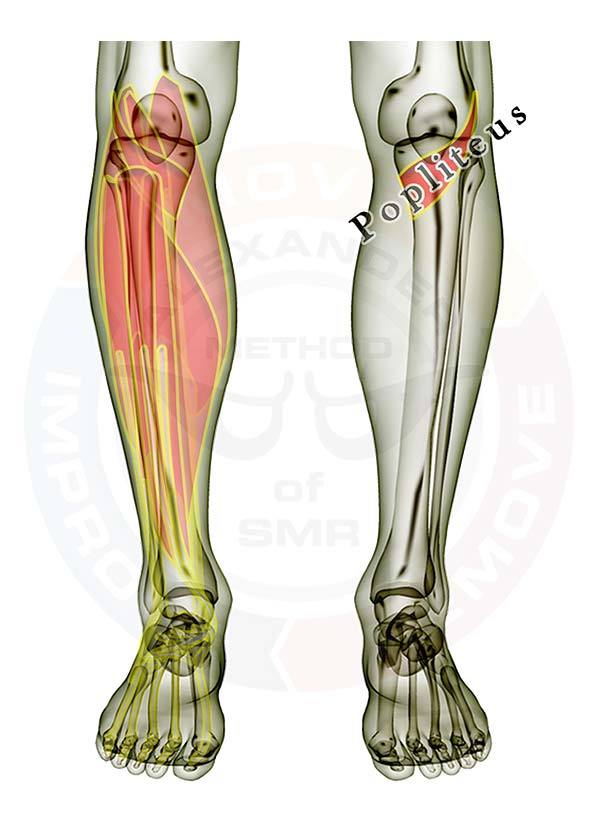 This SMR exercise is a variation of the Adductors Roll movement to address all of the muscle mass along the insides of your thighs. You may find this exercise easier. If the Adductors Roll is too intense to work with, then practice the Cricket to more gently work out the "junk" in your inner thighs. It may take a month or two to help your muscles along to become healthy enough to handle the second Primary technique (which is the preferred standard SMR technique for the adductors). If you have tightness or discomfort of the hip or the inside of your knees, then this exercise is likely to help. |
|
For written instructions, click here. (Video coming soon!) Click here to see the rest of the SMR Techniques. |
|
Be sure to post your questions and comments below. We want to provide the best instruction to help you recover from your workouts. **All information is provided for educational purposes only. You should consult your doctor before attempting any exercises you read on this page or any page on this website.** |
Category: Knee Issues
Popliteus

Pictured above is the popliteus muscle. It unlocks and bends your knee. It attaches to the outer portion of the back of your thigh bone very near your knee and to the upper portion of the inside rear of your largest lower leg bone (the tibia). If this muscle locks up it will feel like a tight ball behind the knee.
If this muscle regularly locks up on you, then you need to work on your quads EVERY DAY. Your quads extend (straighten) your knee, and the popliteus flexes your knee. The quads are MUCH stronger than the popliteus (and all the other knee flexors, for that matter). Be sure you check the other muscles that attach to the knee when dealing with popliteus trouble.
The muscles are layered, showing how some of the muscles are covered by the others. All of the muscles are see-through so that you can appreciate the location and size of each muscle relative to the others.
Click here for a list of all the muscles.
Muscles that cross or attach to the hip or thigh bone (femur) and attach below the knee joint and DO NOT attach to the knee cap (patella)
Lower Leg
The following muscles attach across or below the knee.
Click the appropriate link for your interest.
Muscles that cross the knee
Muscles that pass or attach between the knee & ankle
- Gastrocnemius
- Popliteus
- Plantaris
- Soleus
- Peroneus Longus
- Peroneus Brevis
- Flexor Digitorum Longus
- Flexor Hallucis Longus
- Posterior Tibialis
- Anterior Tibialis
- Extensor Digitorum Longus
- Extensor Hallucis Longus
Good luck working out those tight knots.
If you have any questions, please post a comment. We try to respond within 24 hours.
We're here to help you get more out of your training!
Gastrocnemius

Pictured above is the gastrocnemius muscle. It pulls your heel toward your thigh and also flexes your knee. It attaches to the back of your thigh bone very near your knee and to the upper portion of the outside of your Achilles tendon. Your soleus muscle also attaches to the Achilles tendon, but on the inside (the other side that the gastroc attaches to). Your soleus muscle is VERY likely to need LOTS of stretching and SMR attention. Occasionally, the gastroc will need attention too.
The muscles are layered, showing how some of the muscles are covered by the others. All of the muscles are see-through so that you can appreciate the location and size of each muscle relative to the others.
Click here for a list of all the muscles.
Muscles that cross or attach to the hip or thigh bone (femur) and attach below the knee joint and DO NOT attach to the knee cap (patella)
Lower Leg
The following muscles attach across or below the knee.
Click the appropriate link for your interest.
Muscles that cross the knee
Muscles that pass or attach between the knee & ankle
- Gastrocnemius
- Popliteus
- Plantaris
- Soleus
- Peroneus Longus
- Peroneus Brevis
- Flexor Digitorum Longus
- Flexor Hallucis Longus
- Posterior Tibialis
- Anterior Tibialis
- Extensor Digitorum Longus
- Extensor Hallucis Longus
Good luck working out those tight knots.
If you have any questions, please post a comment. We try to respond within 24 hours.
We're here to help you get more out of your training!
Gluteus Minimus

Pictured above is the gluteus minimus muscle. It primarily works to extend (open) the hip. However, it has a small portion of muscle fibers that cross in front of the hip, so it can work as a weak hip flexor, too. If this muscle is overly tight then it is EXTREMELY LIKELY that you need to address the rectus femoris and the psoas (in that order).
The muscles are layered, showing how some of the muscles are covered by the others. All of the muscles are see-through so that you can appreciate the location and size of each muscle relative to the others. You can access individual muscle detail for all the other muscles in the body with our Coach membership.
Individual hip, lower back & thigh muscles you might be interested in: (any inactive links will be live soon)
Click here for a list of all the muscles.
Muscle that crosses the hip/lower back joint and crosses the hip/thigh joint (attaches to the spine and the femur)
Muscles that attach to the hip and the spine and/or ribs
- Rectus Abdominus
- External Abdominal Oblique
- Internal Abdominal Oblique
- Transverse Abdominus
- Latissimus Dorsi
- Iliocostalis Lumborum
- Longissimus Thoracis
- Quadratus Lumborum
- Multifidi
Muscles that attach to the hip and the thigh bone (femur)
- Iliacus
- Rectus Femoris
- Tensor Fasciae Latae
- Sartorius
- Gracilis
- Adductor Magnus
- Adductor Longus
- Adductor Brevis
- Pectineus
- Gluteus Maximus
- Gluteus Medius
- Gluteus Minimus
- Piriformis
- Superior Gemellus
- Obturator Internus
- Inferior Gemellus
- Obturator Externus
- Quadratus Femoris
- Biceps Femoris
- Semitendonosis
- Semimembranosis
Good luck working out those tight knots.
If you have any questions, please post a comment. We try to respond within 24 hours.
We're here to help you get more out of your training!
Gracilis

Pictured above is the gracilis muscle. It runs from your pubic bone to just below your knee on the inside of your leg. It primarily works as a stabilizer for the leg on the hip joint and pulls the leg inward. When this muscle is overly tight (and this is true for many of us), you will have trouble comfortably opening your legs really wide. This leads to compromised leg positioning for some functional movements such as the deep squat.
The muscles are layered, showing how some of the muscles are covered by the others. All of the muscles are see-through so that you can appreciate the location and size of each muscle relative to the others. You can access individual muscle detail for all the other muscles in the body with our Coach membership.
Individual hip, lower back & thigh muscles you might be interested in: (any inactive links will be live soon)
Click here for a list of all the muscles.
Click here to see the hip flexor muscles as a group.
Muscle that crosses the hip/lower back joint and crosses the hip/thigh joint (attaches to the spine and the femur)
Muscles that attach to the hip and the thigh bone (femur)
- Iliacus
- Rectus Femoris
- Tensor Fasciae Latae
- Sartorius
- Gracilis
- Adductor Magnus
- Adductor Longus
- Adductor Brevis
- Pectineus
- Gluteus Maximus
- Gluteus Medius
- Gluteus Minimus
- Piriformis
- Superior Gemellus
- Obturator Internus
- Inferior Gemellus
- Obturator Externus
- Quadratus Femoris
- Biceps Femoris
- Semitendonosis
- Semimembranosis
Good luck working out those tight knots.
If you have any questions, please post a comment. We try to respond within 24 hours.
We're here to help you get more out of your training!
Semimembranosis

Pictured above is the semimembranosis. It is one of the two internal hamstring muscles that attaches just below the inside of your knee.
The leg on the right has the semimembranosis labeled. The leg on the left displays all the muscles you can address on the back of your thigh in portions of the region of the semimembranosis. All of the muscles in the left leg are see-through so that you can appreciate the location and size of each muscle relative to the others. You can access individual muscle detail for the hamstings and all the other muscles in the body with our Coach membership.
Click here for a list of all the muscles.
Click here to view the hamstrings all together.
Additional hamstring muscles you might be interested in:
- Biceps Femoris
- Semitendonosis
- Semimembranosis
Good luck working out those tight knots.
If you have any questions, please post a comment. We try to respond within 24 hours.
We're here to help you get more out of your training!
Semitendonosis

Pictured above is the semitendonosis. It is one of the two internal hamstring muscles that attaches just below the inside of your knee.
The leg on the right has the semitendonosis labeled. The leg on the left displays all the muscles you can address on the back of your thigh in portions of the region of the semitendonosis. All of the muscles in the left leg are see-through so that you can appreciate the location and size of each muscle relative to the others. You can access individual muscle detail for the hamstings and all the other muscles in the body with our Coach membership.
Click here for a list of all the muscles.
Click here to view the hamstrings all together.
Additional hamstring muscles you might be interested in:
- Biceps Femoris
- Semitendonosis
- Semimembranosis
Good luck working out those tight knots.
If you have any questions, please post a comment. We try to respond within 24 hours.
We're here to help you get more out of your training!
